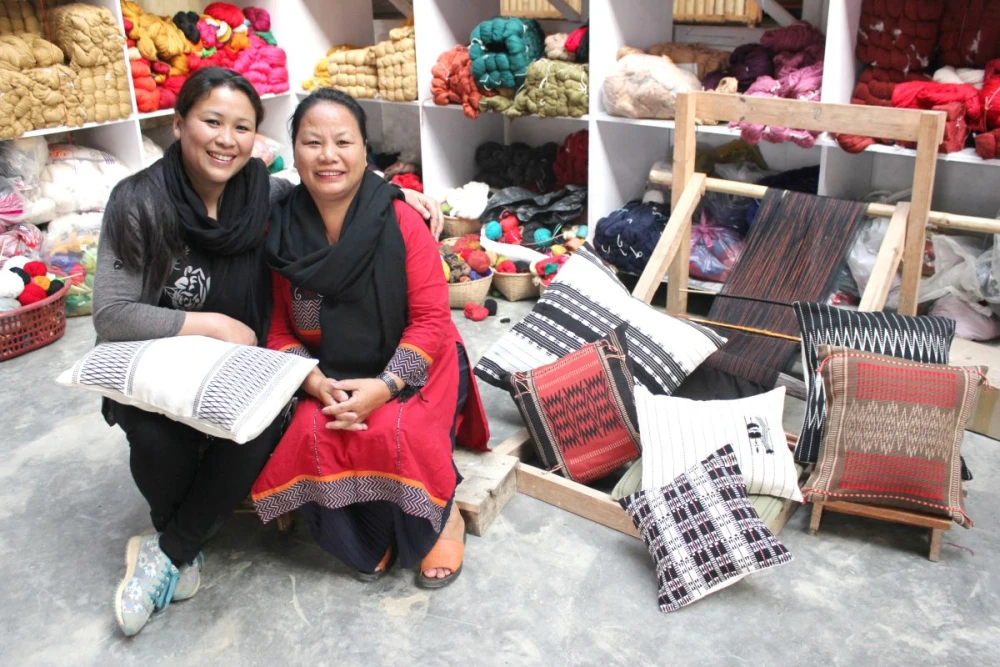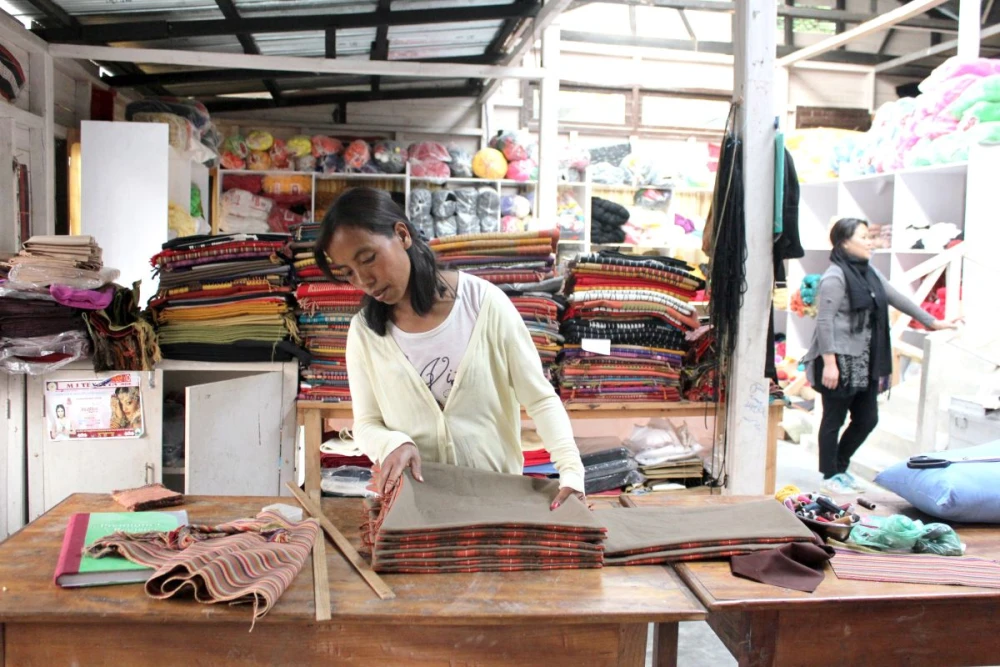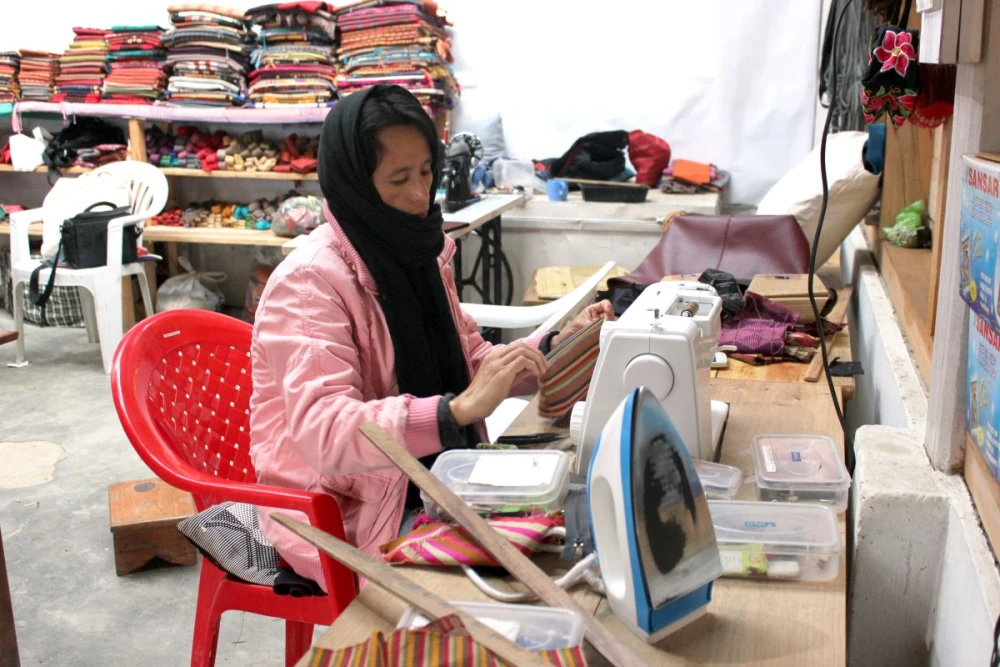Khwepeloü Naro at her loom in Chizami Village in Phek district, Nagaland (Morung Photo)
Looking at a livelihood program that transformed the lives of farmer-weavers in Phek
Morung Express Feature
Chizami (Phek) | April 4
It was hilarious for Khwepeloü Naro (49) to see the colours. Having learnt weaving on the back strap loom with black and white yarn, red and green if luxury permitted, Naro giggled endlessly with her weaver friends at the yarn available at Chizami Weaves—magenta, orange, purple, beige. But the amusement soon turned to obsession.
Naro, a farmer-weaver from Chizami Village in Phek district, learnt to weave from her mother, who grew cotton on her field. Yarn was never enough to try the designs that swarmed her dreams. As she went through a marriage with an able carpenter, having four sons together, Naro did more farming than weaving, earning little, just about surviving.
Ten years ago, in 2008, much of that changed. The North East Network (NEN) in Nagaland started Chizami Weaves, a weavers’ livelihood program. Seven expert weavers, including Naro, were chosen to begin the experiment. Led by Seno Tsühah at the time, Chizami Weaves would buy the yarn, teach the weavers the shapes and sizes for contemporary crafts like cushions or table mats, the weavers would take the yarn by the kilo, bring back the woven material, get paid for it, and Chizami Weaves would market the finished goods in exhibitions all over the country.

“I could not wait for the sun to rise! I would think of new designs in my sleep,” says Naro, speaking in Khezha, about the dreams Chizami Weaves made possible. From 2008, she weaved as she liked with an array of colours at her service, on her own terms, and generated a regular income. “I helped our children through school. Before, I was always struggling to just gather food but now I have more time to weave, innovate and lead a secure life,” explains the shy Naro, now a master trainer to more than 600 weavers from 14 villages whose livelihoods are facilitated through Chizami Weaves.
A decade long weave
Neitshopeü Thopi (35), Program Associate at NEN, interviewed for a position at the Chizami Weaves in 2008 knowing little of what she was getting into. Growing up in Chizami village, she was rooted in the tradition of weaving but, like most weavers, knew little about marketing. From there, she took hold of Chizami Weaves’ reins alongside motley of women colleagues, particularly Kezunyipeü Tsühah (48) who is not just a Program Assistant at NEN but, now, also the Chairperson of the Chizami Women’s Society. Together, they wove a program that continues to sustain the livelihood of weavers from three blocks of Phek district—Chizami, Pfutsero and, since 2017, Meluri.
“Naga weavers have great skills but no regular income. We started this to create a source of income for them while promoting Nagaland’s textiles tradition,” says Thopi while walking The Morung Express through the Weavers’ Unit they set up on the NEN campus in Chizami—here, they train weavers, manufacture and sell finished goods. “We work purely with household weavers in Chakhesang rural areas who use the back strap loom. For most of these women, agriculture is the primary source of livelihood so we started with the hope that weaving would generate some part time income for them.”

But enthusiasm among the weavers to take part in this decentralized model bubbled. The weavers were not hired by Chizami Weaves for a salary —“it is not a factory,” notes Thopi—but could work freely whenever they wanted to and get paid wages as soon as they had woven the goods of their choice. Wages were fixed, and enhanced, in consultation with the weavers.
In 2008, Chizami Weaves sourced their first yarn sample from New Delhi: 30 kilos for a little more than Rs. 9000. In 2016, the program needed to source more than 1000 kilos of yarn worth more than Rs. 10 Lakh!
The model worked so well, it made them “giddy”—metaphorically and physically. The unique designs that the weavers created, with help from designers, form psychedelic lines and triangles that “made the weavers giddy while working on them!” laugh Thopi and Tsühah as they explain how the patterns were created. It drew from the earth, from tradition and the creative imagination of the weavers. “Colour schemes in our traditional clothing are very strict, so the weavers were very amused by the new colours but their creative talent came pouring out.”
Apart from traditional shawls and mekhalas, the weavers now make cushion covers, table runners and mats, tea coasters, bags, pouches, purses, waist coats, neck ties, belts, bed covers, stoles, bolsters and mufflers in more than 80 designs! Their products are sold at melas and exhibitions, as well as NEN offices in Chizami, Kohima, Guwahati and Shillong. Their consignments go to artisan galleries in Mumbai and boutique shops in New Delhi, Bangalore and Goa. Hornbill Festival is their biggest market today amidst steady flow of orders through the year from patrons.
The scope of the work expanded so much so that in October 2017, Chizami Weaves became a separate entity under the ‘Nenterprise Trust’ under which all NEN’s livelihood programs are now run.

Designing a challenge
To create this model in a village 88 km away from state capital Kohima, and 162 km from commercial capital Dimapur, was no small task.
First, the weavers, and sometimes their husbands, were not convinced. One could earn more from daily wages. But the idea was to make this a sustained form of income over time, that is, time available. Being farmers, the women are busy on their fields from April to October. Peak weaving time is November to March. Keeping all this in mind, Thopi and Tsühah went from village to village initially to train the weavers in the sizes required for new products—this would determine the size of the bamboo sticks designed to fit the loom. As the money came in with the sale of contemporary items made on traditional loom, more weavers showed interest to earn through their traditional skills, an avenue rarely available to women today with modern education and technology.
“We also trained girls who dropped out of schools, so they had an avenue for income generation,” informs Thopi.
Their second challenge was quality control. “It took us two years just to figure out the right count of yarn, shapes and sizes,” explains Tsühah. “Even now we have problems of slanting lines because the back strap loom is not a machine that cuts perfect sizes and shapes.” Working on a loom for hours means back and eye issues for weavers that need constant attention to the health of workers, a sector that the NEN in Nagaland has actively worked in since its inception. It helped keep channels of dialogue and assistance open.
The third challenge came from the market itself. Textile factories in neighbouring states began to plagiarise their designs through block printing. The products, thus made, were far cheaper and easier to sell. This is a challenge tricky to negotiate given the unscrupulous profit-oriented technologies of the market. “We do not want to patent any designs and we want to keep paying fair prices to the weavers so we still don’t know a way to deal with this,” admits Thopi.
Finally, what stops Chizami Weaves from drawing all-out profits, after 10 years, is governance. “Poor roads mean poor transportation and increased cost just to get the weaves from one place to the other. To top it all, demonitisation hit us quite hard and there is no Digital India here thanks to the limited network!” lists Thopi, hoping for some help from the government in terms of marketing.
But with or without help from the government, employees at Chizami Weaves are now undergoing finance training, hoping to set foot into the world of online marketing of an ever expanding line of products and designs. They are not shy to collaborate with designers from outside the region and their willingness to open access to their work has led to sturdy solidarities.
Weavers who have worked with Chizami Weaves have become confident decision shapers in their own communities, some even becoming members of village councils. Though, as Khwepeloü Naro, points out, “I still need to overcome the language barrier, I am no more worried whether every thought I have is right or wrong. With dignified labour comes the dignity to make decisions for myself, my family and my community,” reflects Naro as she makes us a final cup of pika and packs her jhum field basket.
During this year’s Biodiversity Festival, Naro won the ‘Best Designer’ award. Another weaver won the ‘Highest Earner’ award. Somewhere in the biodiversity of their jhum fields, these farmer-weavers find design inspiration that are finding ways into a world unknown to them so far. With the Chizami Weaves tag though, a patron will be able to locate them. A collective space of sisterhood is thus blooming, designed in a dream, woven on a back strap loom.






